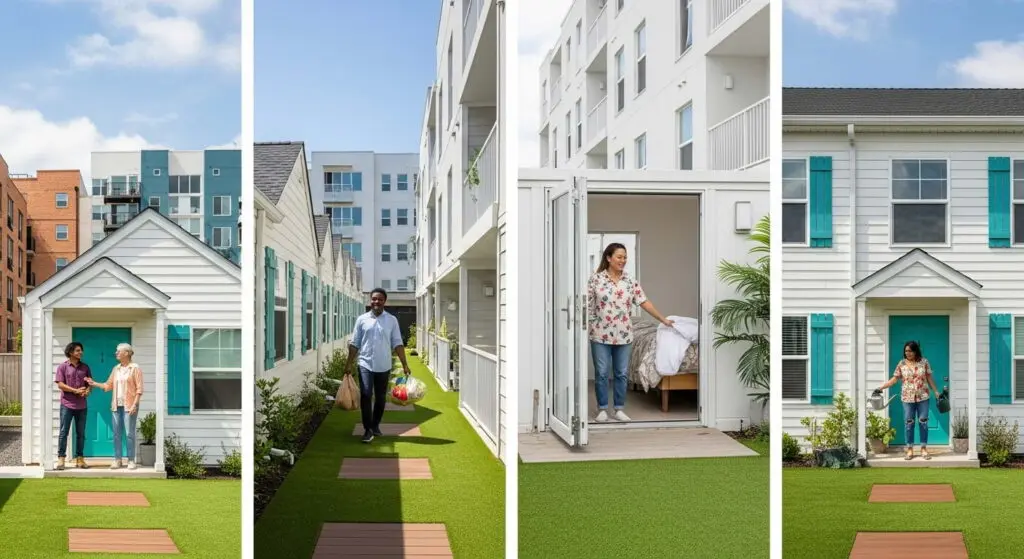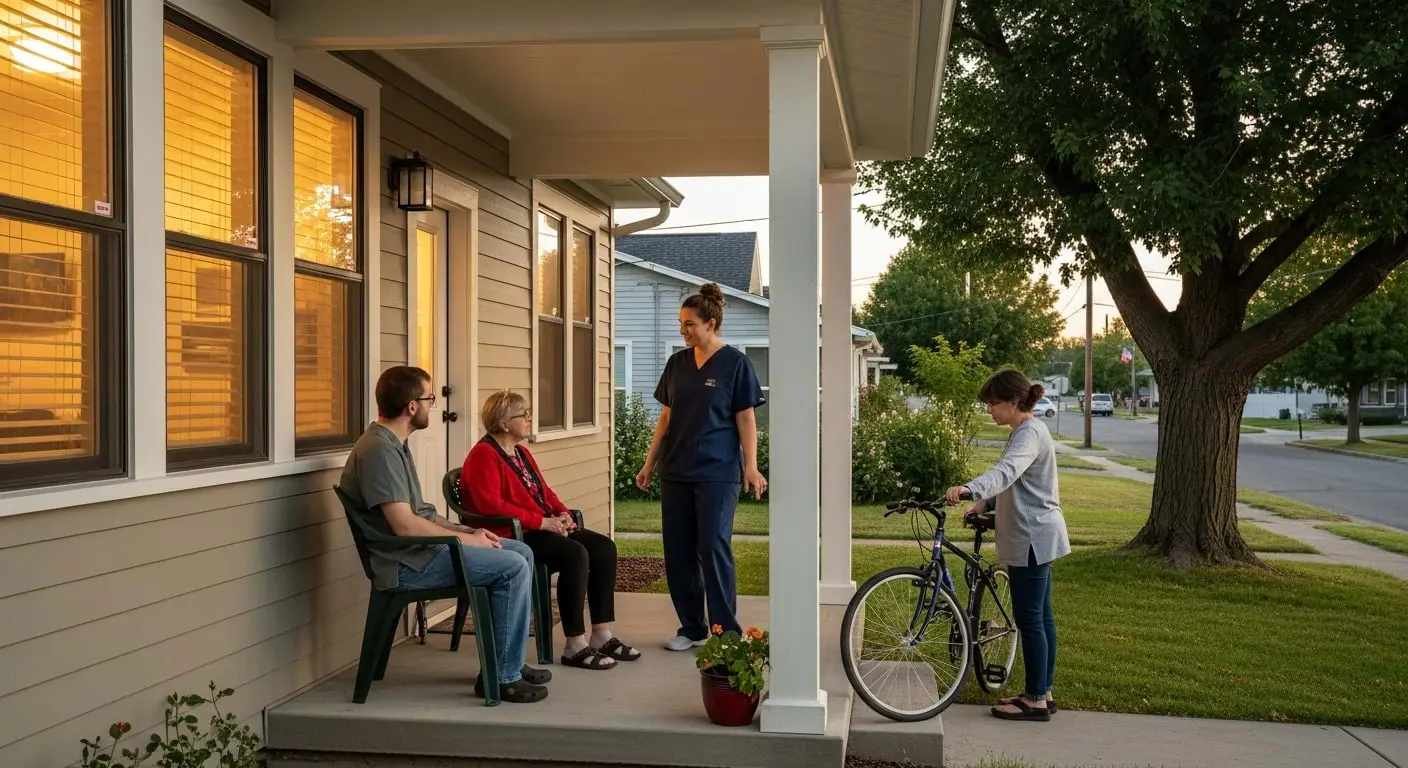Transitional housing is temporary, supportive accommodation for individuals experiencing homelessness, addiction recovery, domestic violence, and more. Transitional housing programs help stabilize individuals as they move toward permanent housing – an essential step in addressing barriers to long-term housing security.
Transitional housing meaning extends beyond shelter; it represents a vital bridge to independence and reintegration.
In this blog, we explore how transitional housing works, supportive services provided, examples and styles of transitional housing, its benefits, and more.
Key Takeaways
- A Bridge to Stability: Transitional housing is a temporary, supportive living arrangement designed to help individuals and families move from crises like homelessness, domestic violence, or addiction to permanent, stable housing.
- Structured Support: Residents typically stay for up to 24 months and are required to engage in supportive services such as case management, job training, counseling, and life skills development.
- Diverse Populations Served: These programs assist various groups, including families experiencing homelessness, youth aging out of foster care, survivors of domestic abuse, and people recovering from addiction.
- Proven Benefits: Transitional housing is effective at increasing long-term housing stability, building self-sufficiency through skill development, and providing a guided pathway to independent living.
Table of Contents
What is Transitional Housing?
Transitional housing is temporary, supportive housing that bridges the gap between homelessness and permanent housing, helping individuals stabilize and rebuild their lives.
How Does Transitional Housing Work
Transitional housing provides temporary accommodation, usually up to 24 months, to individuals, youths, and families experiencing homelessness, fleeing domestic abuse, or recovering from addiction.
Eligibility varies by program but often includes low-income status, recent homelessness, or referrals from shelters or social services. Residents are typically required to participate in homelessness assistance and support programs, such as counseling, job training, addiction recovery, and rehabilitation programs.
Residents of transitional housing are closely supervised to ensure safety, accountability, and progress toward self-sufficiency.
Supportive Services Provided

Typical services offered in supportive housing include:
- Case management to help set and achieve personal goals.
- Counseling for emotional support and trauma recovery.
- Job training and employment assistance.
- Housing search assistance to secure permanent housing.
- Life skills development such as budgeting, cooking, and time management.
- Mental health and substance use support, including therapy and recovery programs.
Who Uses Transitional Housing
Nearly 327,000 people live in emergency and transitional locations, including transitional housing, according to American Community Survey (ACS) 5-year estimates from 2018-2017. However, a U.S. Department of Housing and Urban Development (HUD) point in time study, estimated there were 582,500 sheltered people in 2022 alone.
The main groups served by transitional housing are:
- Individuals and families experiencing homelessness: Those without stable shelter receive support to regain housing and stability. According to the ACS study, among the sheltered population aged 16 and older who are experiencing homelessness, nearly 15% were unemployed, while an additional 61% were not participating in the labor force. Furthermore, 40% of this population were female, 8% were under the age of 18, and 8% were aged 65 or older.
- Youth: Young people aging out of foster care or fleeing unsafe environments are offered safe housing and life skills training. An estimated 4.2 million youth experience some form of homelessness in the U.S. each year.
- Survivors of domestic violence: Individuals escaping abuse are provided with secure, supportive housing to recover and rebuild. The National Low Income Housing Coalition’s Opportunity Starts at Home campaign found that on one day in 2023, 44,616 adult and child victims of domestic violence in the U.S. found refuge in emergency shelters, transitional housing, hotels, or other housing provided by local programs.
- People with mental health or addiction challenges: Over half of adults in permanent supportive housing have a mental health or co-occurring mental health and substance use disorder, according to the Substance Abuse and Mental Health Services Administration (SAMHSA). Those in recovery receive structured support to manage their conditions and work toward independent living.
Examples and Styles of Transitional Housing

Transitional housing doesn’t follow a single architectural design – it’s a flexible concept that adapts to different community needs and resources. It may take the form of:
- Group homes, where residents share living spaces and receive onsite support.
- Apartment-style units, offering private or semi-private spaces within a larger facility.
- Scattered-site apartments, where individuals live independently in various locations with ongoing case management.
This range of styles allows programs to tailor housing environments to specific populations and support goals.
Key Differences: Transitional vs. Supportive and Permanent Housing
Although the terms transitional housing, supportive housing, and permanent housing are often used interchangeably, there are key differences:
| Type | Length of Stay | Services Provided | Stability level |
Transitional housing | Up to 24 months. | Required participation in support programs. | Medium – temporary, the goal is progression. |
Supportive housing | Long-term or indefinite. | Intensive, ongoing support (mental health, addiction, etc.) | High – permanent with support. |
Permanent housing | No time limit. | Few or no required services. | Highest – independent living. |
Benefits of Transitional Housing

The benefits of transitional housing programs include:
- Increased housing stability by providing a safe, temporary place to live: A study by the U.S. Department of Health and Human Services found that 73% of youth exiting transitional housing programs achieved stable housing outcomes.
- Skill-building through life skills training, counseling, and job readiness programs: A HUD study revealed that 62% of mothers in transitional housing programs were employed at the 12-month follow-up, compared to a lower percentage at program entry. Additionally, transitional programs for youth contribute to higher employment outcomes for young adults.
- Smoother transition to independent living with ongoing support and guidance: Research indicates that youth supportive transitional housing programs are essential for addressing youth homelessness, providing a pathway to independence and stability. HUD also found that mothers who received services from transitional housing programs found them helpful, and a much higher percentage of mothers worked after exiting the programs.
Frequently Asked Questions About Transitional Housing
Below are answers to some of the most asked questions about transitional housing:
What is the meaning of a transition house?
A transition house is temporary, supportive housing for people escaping domestic violence, homelessness, or other crises.
What’s a transitional house plan?
Transitional housing doesn’t follow a single architectural design, it’s a flexible concept that adapts to different community needs and resources.
What is transitional homelessness?
Transitional homelessness is a short-term episode of homelessness, often due to sudden life changes like job loss or eviction.
What are transitional properties?
Transitional properties are real estate assets that undergo changes in use, ownership, or value, often in areas undergoing redevelopment or gentrification.
The Role of Transitional Housing in Ending Homelessness
Transitional housing serves as a critical bridge between homelessness and permanent housing. Transitional housing offers temporary, supportive shelter to individuals and families in crisis, including people experiencing homelessness, fleeing domestic violence, or recovering from addiction.
It provides housing stability, skill-building opportunities, and guided support to help people regain independence. As part of the broader homelessness response system, transitional housing plays a key role in preventing long-term homelessness and promoting self-sufficiency.
Learn more or find support:
Visit HUD Exchange – Homelessness Assistance or SAMHSA Homeless Programs for resources and information.
Contact us to learn more about Acuity International’s comprehensive transitional housing case management and wraparound support services for vulnerable groups.
